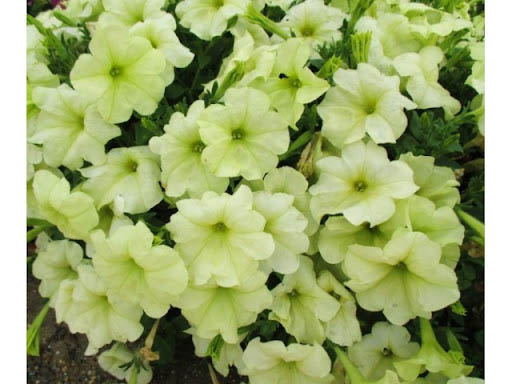Petunia Debonaire has a unique color scheme. Plant height 25-38 cm. Forms a dense spherical bush 25-30 cm in size. Flower diameter 6-8 cm. It is used both for flowerpots and flower beds.

* Petunia blooms in the year of sowing, therefore it is often used as an annual, although if desired, a favorite plant can be dug out of the garden in the fall and kept at home until the next season, also propagating it.
Petunia is very photophilous (tolerates weak shading) and thermophilic; it develops better on fertile, light, slightly acidic soils. With the onset of prolonged cold weather and rains, the petunia stops flowering, and when good weather sets in, it resumes it again. Petunia is drought-resistant, but with regular watering, it will thank you with more lush beautiful bushes and abundant flowering.
Petunias are propagated by seeds and cuttings. Petunias have very small seeds, so you need to pay a lot of attention to the developing small seedlings of petunias and ensure regular care. Petunia seeds are sown for seedlings from February to the end of March; surface sowing, without soil incorporation. It is advisable to sow petunia seeds, as well as other small-seeded plants, rarely (so that the seedlings do not oppress each other) and take measures before sowing to prevent the appearance of a "black leg" and soil mold. You can sow petunia seeds on snow (it is placed on the surface of the substrate in a pot with a layer of 1-1.5 cm), on which the seeds are clearly visible; melting snow pulls the seeds into the soil. Crops are covered with glass or film.
For the germination of petunia seeds, heat is needed (23-25 degrees); shoots appear in a week and a half. The top layer of earth in a pot with crops should not be damp, but should not dry out, so seedlings are often checked (at least twice a day). It is better to water petunia seedlings from below, from a pallet. In order to avoid the appearance of a "black leg", petunia seedlings, after drying the soil, are periodically sprayed with a light solution of potassium permanganate, regularly turned over and wipe the glass, ventilate the "greenhouse". Petunia seedlings are grown at a temperature of 20 degrees.
Rare planting of seeds allows picking petunia seedlings when they develop 3-4 true leaves. But if necessary (the rapid spread of the "black leg"), an urgent picking of seedlings is carried out at earlier stages of development in order to save at least part of the crops. Before picking seedlings, the soil is moistened. Petunia seedlings have a short subcotyledon knee and a rosette of leaves, therefore, when picking, the seedlings are hooked with a stick, taken by the leaf and carefully removed from the ground, keeping the earth on the roots. When picking, it is impossible to deepen the growth point of the petunia into the ground, therefore, while filling with soil, the cotyledons of the seedling are slightly raised above the ground.
When the petunia seedlings grow up, they begin to be fed (seedlings stretched out due to lack of light do not need to be given nitrogen fertilizers).
Petunia seedlings are planted in the ground after the end of spring frosts, at a distance of 20-40 cm. Petunia has branched roots that do not penetrate deep into the soil; when transplanted, its root system is easily restored.
In regions with a mild climate and warm early spring, petunia seeds can be sown directly into the ground. Petunias bloom 55-95 days after germination, depending on the variety. In the summer, you can carry out cuttings of the shoots of your favorite petunias.












